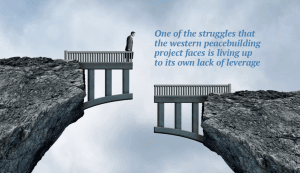
Helping Established and New Peacemakers Work Together
Brief Summary New, and newly prominent, actors are playing an increasing role in peacemaking, and mediation. Based on interviews with 30 senior peacemakers and mediators,

Brief Summary New, and newly prominent, actors are playing an increasing role in peacemaking, and mediation. Based on interviews with 30 senior peacemakers and mediators,

Brief Summary This research draws on interviews with 30 highly experienced mediators and peacemakers to identify the most effective peacemaking strategies. Given that we are

Interviews with 30 senior peacemakers and mediators revealed tensions between peacemaking and peacebuilding. While peacemaking was seen by some as too elite-focused, peacebuilding was seen as “spinning wheels” or having projects on the margins of a conflict that did not actually address the conflict. The question then is: How can peacemaking and peacebuilding work together for better outcomes? A key lies in effective linkage between the two and the ability of each to tell a better story about itself.

Thirty, highly experienced mediators and peacemakers were interviewed and asked, ‘What works?’ By far the most common answer was the importance of having long-term networks of inter-party or inter-group contact in place. These Track 1.5 networks provided spaces for awkward conversations, sustained contact and the floating of ideas. They can act as nudge mechanisms, acculturating actors to new ways of thinking and possible routes out of conflict.